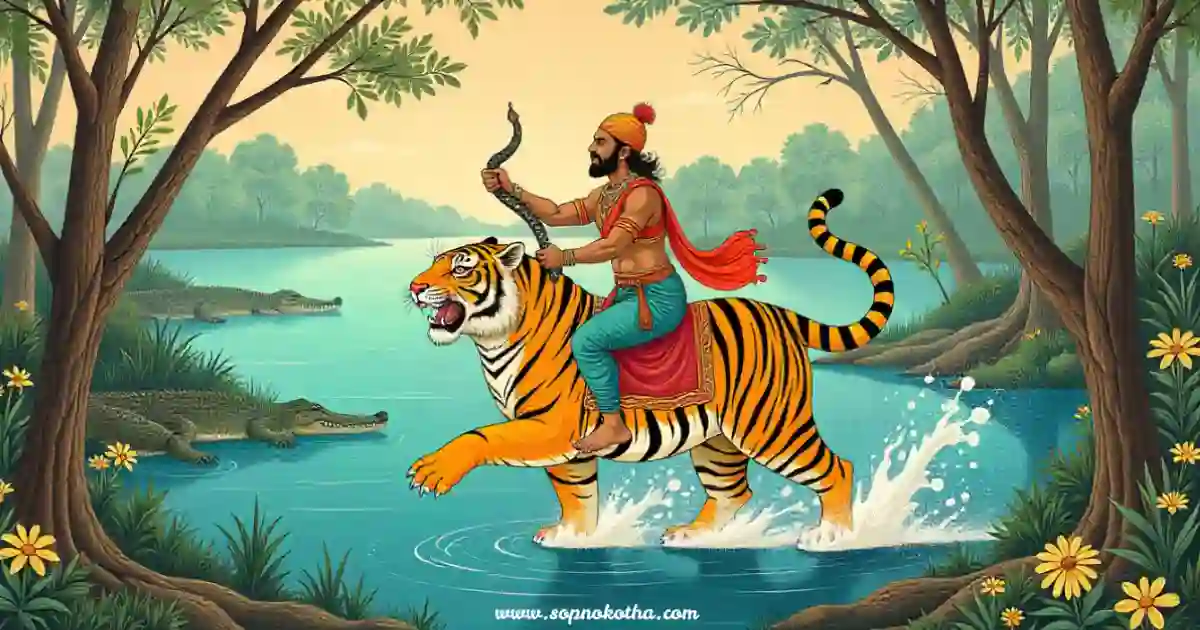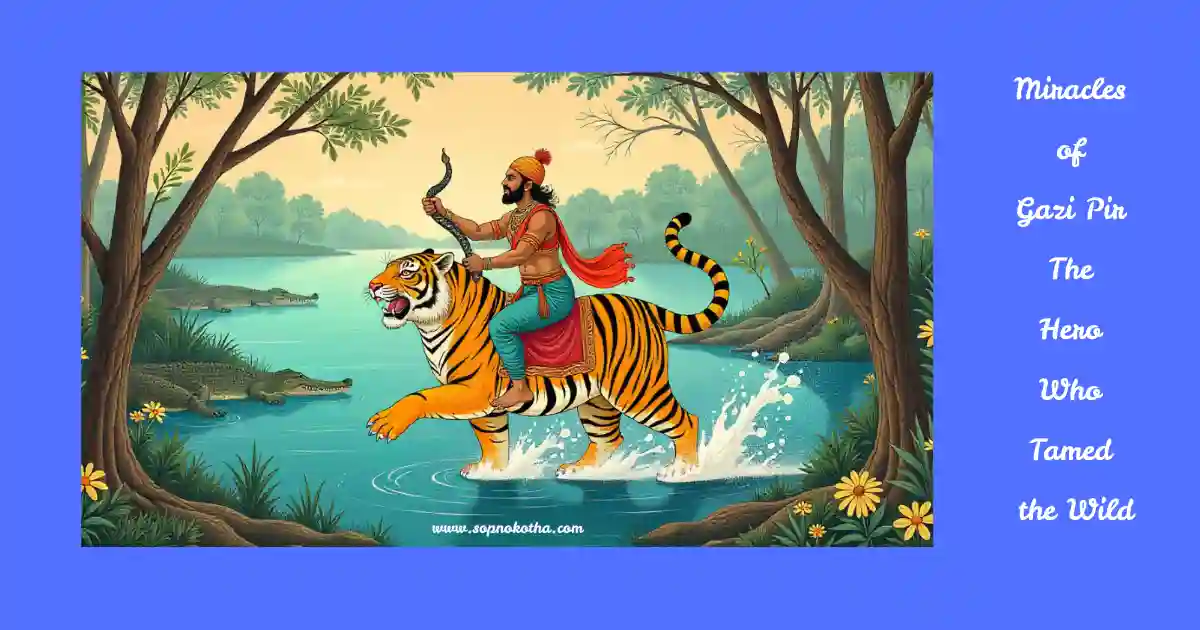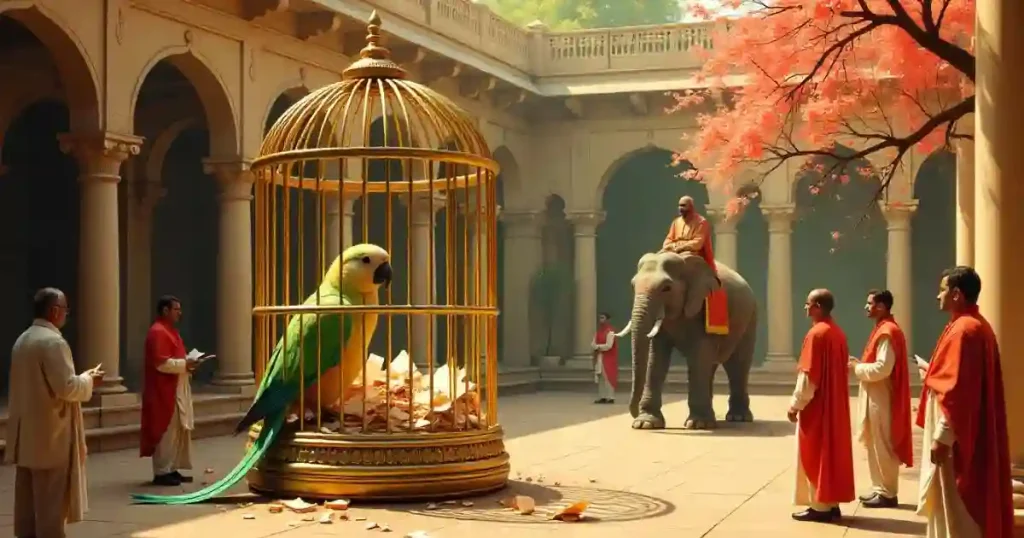Gazi Pir is a fascinating figure rooted deeply in Bengali myths and legends. Revered as a saint and protector, he is remembered for his mystical powers and ability to calm dangerous beasts in the Sundarbans. His heroic deeds—fighting crocodiles, taming tigers, and safeguarding villagers—have immortalized him in folk literature, scroll paintings, and local theatre.

In this lesson, we explore the story of Gazi Pir and his legacy in Bangladeshi culture and folklore.
Read more – Craft: Powerful Insights into the Timeless Beauty U2L4
Bangla Meaning of Important Words and Phrases
| English Word/Phrase | বাংলা অর্থ |
| Myths and legends | পৌরাণিক কাহিনি ও কিংবদন্তি |
| Muslim saint | মুসলিম সাধক |
| Spread Islam | ইসলাম প্রচার করেছিলেন |
| Credited with many miracles | অনেক অলৌকিক ঘটনার জন্য বিখ্যাত |
| Calm dangerous animals | বিপজ্জনক প্রাণীদের শান্ত করতেন |
| Docile | অনুগত / শান্ত |
| Depicted in scroll paintings | পট্টচিত্রে চিত্রিত |
| Fierce-looking Bengal tiger | ভয়ঙ্কর দর্শন রয়েল বেঙ্গল টাইগার |
| In no apparent danger | কোনো দৃশ্যমান বিপদে ছিলেন না |
| Fought crocodiles | কুমিরের সঙ্গে যুদ্ধ করেছিলেন |
| Watery jungle | জলময় অরণ্য |
| Predatory animals | শিকারি প্রাণী |
| Within bounds | নিয়ন্ত্রণের মধ্যে |
| Cultivate their lands | তাদের জমি চাষ করতে |
| Folk literature | লোকসাহিত্য |
| Indigenous theatre | স্থানীয় নাট্যকলা |
| British Museum | ব্রিটিশ জাদুঘর |
Paragraph-wise Bangla Explanation
Paragraph:
According to some myths and legends, Gazi Pir was a Muslim saint who is said to have spread Islam in the parts of Bengal close to the Sundarbans. He was credited with many miracles.
Explanation (বাংলা ব্যাখ্যা):
কিছু পৌরাণিক কাহিনি ও কিংবদন্তি অনুযায়ী গাজী পীর ছিলেন একজন মুসলিম সাধক যিনি সুন্দরবনের নিকটবর্তী বাংলার কিছু অঞ্চলে ইসলাম প্রচার করেছিলেন। বলা হয়, তিনি বহু অলৌকিক ঘটনার জন্য খ্যাত ছিলেন।
Paragraph:
For example, he could supposedly calm dangerous animals and make them docile. He is usually depicted in paats or scroll paintings riding a fierce-looking Bengal tiger, a snake in his hand, but in no apparent danger.
Explanation (বাংলা ব্যাখ্যা):
উদাহরণস্বরূপ, বলা হয় তিনি বিপজ্জনক প্রাণীদের শান্ত করতে পারতেন এবং তাদের অনুগত করতেন। পট্টচিত্রে তাকে সাধারণত এক ভয়ঙ্কর রয়েল বেঙ্গল টাইগারের উপর চড়ে, হাতে একটি সাপ ধরে, কিন্তু কোনো ভয়ের চিহ্ন ছাড়াই চিত্রিত করা হয়।
Paragraph:
According to some stories, he also fought crocodiles who threatened the people of a region full of canals and creeks, indeed, a kind of watery jungle bordering the Bay of Bengal.
Explanation (বাংলা ব্যাখ্যা):
কিছু কাহিনিতে বলা হয়েছে, তিনি এমন কুমিরের সঙ্গে যুদ্ধ করেছিলেন যারা উপকূলীয় অঞ্চল—নদী-খাল ও জলাভূমিতে ভরা এলাকায়—মানুষকে হুমকি দিত।
Paragraph:
Because of his alert and vigilant presence, all predatory animals were said to have been kept within bounds. It was also believed that he enabled villagers to live close to forests and jungles and cultivate their lands.
Explanation (বাংলা ব্যাখ্যা):
তাঁর সচেতন ও সতর্ক উপস্থিতির কারণে সকল শিকারি প্রাণী সীমার মধ্যে ছিল বলে বিশ্বাস করা হতো। আরও মনে করা হয় যে, তিনি গ্রামবাসীদের অরণ্যের নিকটবর্তী এলাকায় বাস করতে এবং তাদের জমি চাষ করতে সহায়তা করতেন।
Paragraph:
Consequently, people of these regions would pray to him for protection. The story of Gazi Pir has been preserved in folk literature as well as art and has been performed in indigenous theatre.
Explanation (বাংলা ব্যাখ্যা):
ফলে, এই অঞ্চলের মানুষ তাঁকে রক্ষা করার জন্য প্রার্থনা করত। গাজী পীরের গল্প লোকসাহিত্য ও শিল্পে সংরক্ষিত হয়েছে এবং স্থানীয় নাট্যকলায় পরিবেশিত হয়েছে।
Paragraph:
In fact, some Gazir paat scrolls are part of the collection of the British Museum.
Explanation (বাংলা ব্যাখ্যা):
আসলে, গাজীর পটচিত্রের কিছু অংশ ব্রিটিশ মিউজিয়ামের সংগ্রহে রয়েছে।

Read more – The Parrot’s Tale – Analysis, Symbolism, and Political Satire U1L1
Myths and Legends of Gazi Pir
According to some myths and legends, Gazi Pir was a Muslim saint who is said to have spread Islam in the parts of Bengal close to the Sundarbans. He was credited with many miracles. For example, he could supposedly calm dangerous animals and make them docile. He is usually depicted in paats or scroll paintings riding a fierce-looking Bengal tiger, a snake in his hand, but in no apparent danger.
According to some stories, he also fought crocodiles who threatened the people of a region full of canals and creeks, indeed, a kind of watery jungle bordering the Bay of Bengal. Because of his alert and vigilant presence, all predatory animals were said to have been kept within bounds. It was also believed that he enabled villagers to live close to forests and jungles and cultivate their lands.
Consequently, people of these regions would pray to him for protection. The story of Gazi Pir has been preserved in folk literature as well as art and has been performed in indigenous theatre. In fact, some Gazir paat scrolls are part of the collection of the British Museum.
[This passage/content is taken from the National Curriculum and Textbook Board (NCTB), Bangladesh English textbook for educational purposes only.]
© NCTB Bangladesh. All rights reserved to the original publisher.
Relevant Historical Events
- Islamic Influence in Bengal: During the 13th to 18th centuries, many Sufi saints came to Bengal and played key roles in spreading Islam peacefully. Gazi Pir is thought to be one such spiritual figure tied to the Bengal deltaic region.
- Folk Art Traditions: The tradition of pattachitra or scroll painting in Bengal often celebrated religious heroes like Gazi Pir, integrating myth, religion, and art.
- British Museum Collection: The British colonial period saw many Indian and Bengali art pieces transported to Europe. The presence of Gazir paat in the British Museum reflects this history.
Literary Terms and Their Use
| Term | Explanation | Usage in the Text |
| Legend | A traditional story sometimes regarded as historical but unauthenticated. | The entire story of Gazi Pir is a legend. |
| Myth | A symbolic narrative, often involving supernatural beings. | Myths describe Gazi Pir’s miraculous powers. |
| Imagery | Visually descriptive language. | Scroll paintings showing Gazi on a tiger with a snake in hand. |
| Symbolism | Use of symbols to signify ideas. | Tiger and snake symbolize dominance over nature. |
Short Questions on Gazi Pir
- Who was Gazi Pir according to myths and legends?
- In which part of Bengal did Gazi Pir reportedly spread Islam?
- What kind of miracles was Gazi Pir credited with?
- How is Gazi Pir usually depicted in scroll paintings?
- What animal did Gazi Pir often ride in the depictions?
- What dangerous animals did Gazi Pir fight according to the stories?
- Why were the people of the region afraid of crocodiles?
- What effect did Gazi Pir’s presence have on predatory animals?
- Why did the villagers pray to Gazi Pir?
- Where can some of the Gazir paat scrolls be found today?

Read more – The Legend of Gazi
1. Read the above passage and answer the questions A and B.
A. Choose the correct answer from the alternatives. 1 x 5 = 5
(a) The word ‘saint’ means —.
(i) hero
(ii) hallow
(iii) writer
(iv) mythic character
(b) The phrase in the text ‘credited with’ means —.
(i) responsible for doing something good
(ii) making powerful
(iii) give someone a duty
(iv) deposit money
(c) What does the word ‘depict’ in the text refer to?
(i) detail
(ii) produce
(iii) consult
(iv) portray
(d) The phrase ‘scroll painting’ means —.
(i) painting on a stone
(ii) painting on a role of paper
(iii) painting on sand
(iv) painting on cloth
(e) The word ‘region’ is synonymous to —.
(i) religion
(ii) forest area
(iii) area
(iv) coastal area
B. Answer the following questions. 2 x 5 = 10
(a) What do you know about Gazi Pir?
(b) Describe his nature?
(c) What is depicted in paats or scroll paintings about Gazi Pir?
(d) How did he keep the predatory animals within bounds?
(e) How did he enable villagers to live close to forests and jungles?
2. (i) Read the above text and make a flowchart showing the specialities
of Gazi Pir. (One has been done for you.) 2 x 5 = 10
| 1. Being credited with miracles | ® | 2. | ® | 3. | ® | 4. | ® | 5. | ® | 6. |

